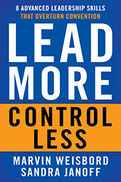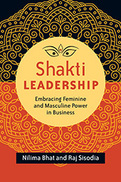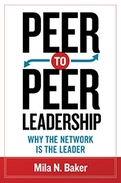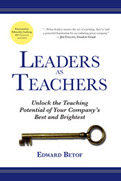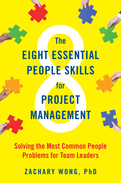In their decades of leading groups all over the world, Marvin Weisbord and Sandra Janoff discovered they could get superior results by creating an unconventional approach to leadership. Leaders still need to get everyone aligned around the same goals. But to maximize energy, creativity, and productivity, they gain more by focusing on structure rather than behavior, enabling people to take responsibility and manage themselves.
Lead More, Control Less describes eight essential skills for establishing a culture of autonomy and self-leadership. Using examples and case studies, Weisbord and Janoff describe how leaders can share responsibility, defuse group conflicts, show everyone the big picture, and more. With this approach, leaders truly gain more control by giving it up.
2016
Too many people, men and women alike, have bought into a notion of leadership that exclusively emphasizes traditionally “masculine” qualities: hierarchical, militaristic, win-at-all-costs. The result has been corruption, environmental degradation, social breakdown, stress, depression, and a host of other serious problems. Nilima Bhat and Raj Sisodia show us a more balanced way, an archetype of leadership that is generative, cooperative, creative, inclusive, and empathetic. While these are traditionally regarded as “feminine” qualities, we all have them. In the Indian yogic tradition they're symbolized by Shakti, the source that powers all life.
Through exercises and inspirational examples, Bhat and Sisodia show how to access this infinite energy and lead with your whole self. Male or female, leaders who understand and practice Shakti Leadership act from a consciousness of life-giving caring, creativity, and sustainability to achieve self-mastery internally and be of selfless service to the world.
The idea of hierarchy is breaking down everywhere, from politics to religion to social relationships-why should leadership be any different?
Our leadership models are stuck in an Industrial Age, top-down mentality. But in our complex, data-drenched, 24/7 world, there is simply too much information coming from too many different directions too quickly for any one leader or group to stay on top of it. Hierarchy is breaking down everywhere—why should leadership be any different? Inspired by the peer-to-peer model of computing used in social networking and crowdsource technologies, Mila Baker shows a new way to lead. Organizations, she says, must become networks of "equipotent" nodes of power—peer leaders. The job of the leader is now to set the overall goals and direction and optimize the health of that network, not tell it what to do. In these organizations, leadership roles shift rapidly to fit the needs of any given situation. Information flows freely so those who need it can find it easily and act on it immediately. Feedback becomes an organic part of the workflow, enabling rapid course corrections. Baker shows how companies like Gore and Herman Miller have achieved long-term success practicing these principles and provides a structure that any organization can adapt to build flexibility, resiliency, and accountability.2009
Every business understands the value of connecting its top leaders to other established and high-potential leaders in the organization. Becton, Dickinson and Company had its leaders make this vital connection in a unique and highly effective way -- through teaching.
Offers a compelling implementation roadmap and includes detailed plans, worksheets, exercises, complete sample training outlines, and other useful tools that speed the transition to leaders as teachers
Dozens of sidebars throughout the book present the participation experiences of leaders at all levels, frequently asked questions (FAQs), and personal testimonials of those who have benefited from participation in the leaders as teacher program.
Most business professionals understand the value of connecting their top leaders to other established and high potential leaders in the organization. Becton, Dickinson and Company (BD), a $6.5 billion medical technology company with 28,000 employees, believes its leaders should make this vital connection in a unique and highly effective way – through teaching. Leaders as Teachers chronicles BD’s 8-year journey to create and deploy a leadership development program that relies on all top leaders (even its CEO) to train other leaders. The initiative, led by author Edward Betof , BD’s vice president and chief learning officer, has produced dramatic results, including measurable business results, a stronger and more supportive learning environment, improved communications and strengthened organizational culture, a more adaptive and change-receptive leadership team, and direct cost savings for the organization.
In addition to its compelling story of change, Leaders as Teachers offers a roadmap for other organization wishing to implement and benefit from BD’s experience. This complete roadmap includes detailed advice on how to introduce the leaders as teachers program and advice on how to overcome resistance to change; how to select, recruit, and train new leaders for the program; and how to evaluate the effectiveness of a fully functioning program. The book provides all the necessary tools, including detailed plans, worksheets, exercises, complete sample training outlines, and extra materials that speed the transition to leaders as teachers and take full advantage of BD’s extensive experience. Dozens of sidebars throughout the book present the participation experiences of BD’s leaders at all levels, frequently asked questions (FAQs), and personal testimonials of those who have benefited from participation in the leaders as teacher program.
• Offers a compelling implementation roadmap and includes detailed plans, worksheets, exercises, complete sample training outlines, and other useful tools that speed the transition to leaders as teachers
• Dozens of sidebars throughout the book present the participation experiences of leaders at all levels, frequently asked questions (FAQs), and personal testimonials of those who have benefited from participation in the leaders as teacher program.
Most business professionals understand the value of connecting their top leaders to other established and high potential leaders in the organization. Becton, Dickinson and Company (BD), a $6.5 billion medical technology company with 28,000 employees, believes its leaders should make this vital connection in a unique and highly effective way – through teaching. Leaders as Teachers chronicles BD’s 8-year journey to create and deploy a leadership development program that relies on all top leaders (even its CEO) to train other leaders. The initiative, led by author Edward Betof , BD’s vice president and chief learning officer, has produced dramatic results, including measurable business results, a stronger and more supportive learning environment, improved communications and strengthened organizational culture, a more adaptive and change-receptive leadership team, and direct cost savings for the organization.
In addition to its compelling story of change, Leaders as Teachers offers a roadmap for other organization wishing to implement and benefit from BD’s experience. This complete roadmap includes detailed advice on how to introduce the leaders as teachers program and advice on how to overcome resistance to change; how to select, recruit, and train new leaders for the program; and how to evaluate the effectiveness of a fully functioning program. The book provides all the necessary tools, including detailed plans, worksheets, exercises, complete sample training outlines, and extra materials that speed the transition to leaders as teachers and take full advantage of BD’s extensive experience. Dozens of sidebars throughout the book present the participation experiences of BD’s leaders at all levels, frequently asked questions (FAQs), and personal testimonials of those who have benefited from participation in the leaders as teacher program.
2020
Whether you're planning future travels or exploring the diverse cultures in your own community, Crossing Boundaries provides strategies for growth and getting out of your comfort zone. Moving between inspirational stories, humorous anecdotes, and helpful conflict resolution tips, Abu Sarah guides you through having personal, meaningful experiences with people from different backgrounds. He sketches a vision of a kind of travel with the power to help heal the divides of a world polarized by seemingly intractable conflicts.
Abu Sarah argues that transformative travel can start at home. He knows this firsthand: a former Palestinian radical, he shares his own moving story of creating connections across his divided hometown of Jerusalem, and of co-founding a tour agency with a Jewish American. Today, they direct Dual Narrative Tours, co-led by guides from different communities in countries like Israel and Palestine, Ireland and Northern Ireland, North and South Vietnam, and many others.
Drawing on these experiences, Abu Sarah's book offers tips on how to meet people naturally and safely, design an inclusive itinerary, shop to support the local economy, deal with setbacks, and much more. A guide for going beyond museums and monuments, this book is for both the first-timer and seasoned veteran. Abu Sarah shows that if you put down your phone and strike up a conversation, you can break through the walls that separate people. You'll discover shared values, build lasting relationships, and realize that far more unites us than divides us.
Wong believes that the best team leaders are problem-solvers and facilitators, so this book provides problem-solving models and tools to diagnose people problems, and facilitative methods, processes, and techniques to correct them. It's an approach that can be personalized to fit any person or situation. Each skill is explained with a well-balanced mix of case stories, examples, strategies, processes, tools, and techniques along with illustrations, graphics, tables, and other visuals to clarify key concepts and their workplace application. To reinforce the most important learnings, Wong includes a “Memory Card” and “Skill Summary” at the end of each chapter.
Nothing is harder than leading people and managing project teams. Being successful takes a combination of knowing human psychology, organizational behaviors, and human factors; having supervisory, process, and communication skills; ensuring good teamwork, high integrity, and strong leadership; and having the ability to integrate and apply these skills to a diverse work team. The Eight Essential People Skills for Project Management is designed for individuals, team leaders, and managers who oversee and coordinate the daily performance of others and who are seeking solutions that they can apply immediately.


